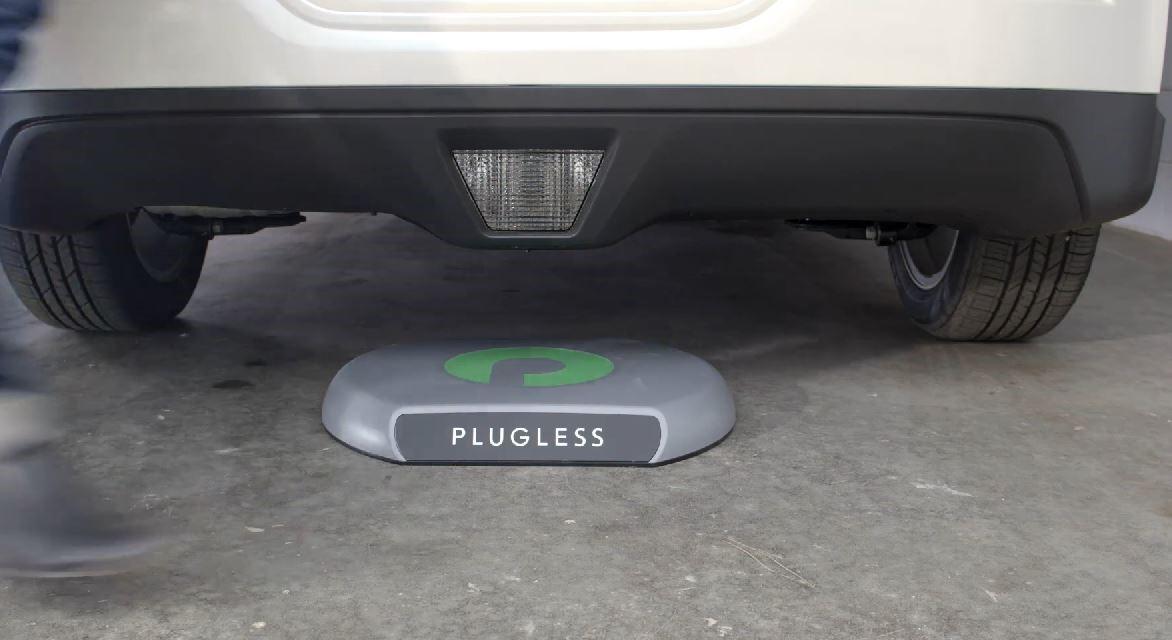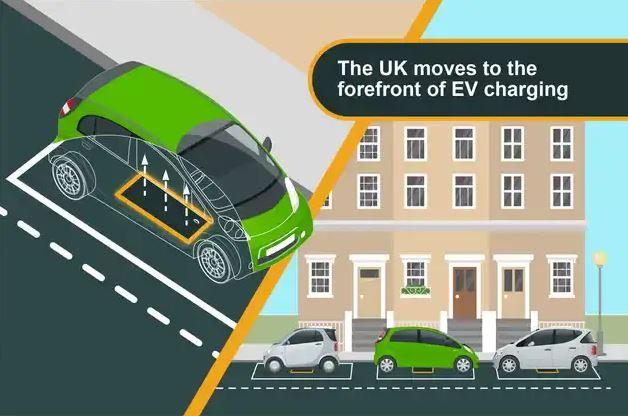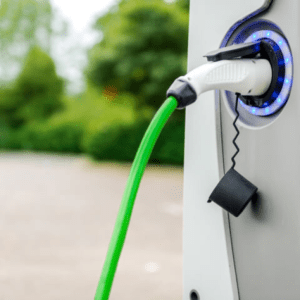Electric car technology is going from strength to strength and it seems like almost every day something new comes along. It is to be expected that the science of EV’s will continue and, as long as those advances are relevant and make our lives as motorists easier, then we should welcome them.
EV cable charging: The standard now.
Right now, electric vehicle owners tether their cars to electricity points using the latest electric charging cables. It’s an easy enough job and for most drivers an over night fill up does the trick; but what if we could do more? What if we could charge our car without connections? Why not take it further? It’s coming, the world of wireless electric car charging and trials of under-the-road systems for charging on the go have been going for some time in Sweden and elsewhere. All the signs are that 2020 is the year when this technology will take off.
Types of Wireless EV Chargers
Plugless Power: Wireless EV Charging Station

As with all wireless electric chargers, Plugless uses inductive charging technology to charge your electric car with eliminates the requirement of any charging cables. The Plugless system uses two aligned magnetic coils to send power to your electric car with a small air gap. Wireless charging is often seen as a better way of charging your electric car as, its effortless, reduces wear and tear, and protects battery health.
The Plugless Power System:
Plugless provides a wireless EV charging system made of 3 main components, the control panel, vehicle adapter, and the parking pad. The control panel is the brain of the device, this is connected to the call of your home or workplace charging station, this device is automatically switched on when you drive over the plugless parking pad. It will then draw electricity from the circuit and pushes the correct amount of electricity to the parking pad. The coils in the parking pad will then convert the electrical power into magnetic energy which can be safely transmitted through the air to the vehicle adapter. The vehicle adapter then converts the magnetic energy back to electricity, which is pass through the onboard charging system to recharge your EV. Easy right!
Advantages:
- Look and design is impressive
- The device can be installed indoors or outdoors
- Charges just as quickly as an EV cable system
- You can still use an EV cable to charge your car
- Easy to algin the parking pad with vehicle adapter
Disadvantages
- Less efficient than a cable system
- The cable the runs from the control panel to the parking pad cannot be moved
- The vehicle adapters can only be fit to specific EVs
- Tesla Model S
- BMW i3
- Nissan LEAF
- Chevrolet Volt
- Requires a 240v/30amp circuit
Connected Kerb

Connected Kerb is an award-winning start-up, that is focused on the residential as this is where your car will stay for 95% of its time. This allows them to focus on lower rates of charging and not compete with commercial rapid chargers. The connected Kerb device sits underneath the ground, this has many advantages vs above the ground solutions:
- Environmentally friendly and doesn’t cause any trip hazards with passers-by.
- The wireless EV charging device is very safe and protected, making the Connected Kerb device more reliable then above the ground solutions.
- Minimises visual disruption to the road
All of this allows the connected kerb devices to have really high uptimes, but if something does go wrong with the wireless charging device the average repair time is only 30 minutes. So, if you decide to install a Connected Kerb device you can be very confident that you will always have a charging system available.
Advantages:
- 4g enabled and upgrading to 5g
- Less susceptible to damage as it’s beneath the ground
- No cables running from a control panel to the charging device
- Low visual impact
- The device is built from 80% recycled materials
- Can use the station to charge via an EV Cable
Disadvantages
- Only for low power charging
- If it breaks it could be difficult to fix
- Not rolled out in the majority of UK locations yet
Wireless EV charging: The standard of the future.
This new technology in concept has already been shown at motor shows and the like. It’s all designed to help make cars increasingly part of our connected world.
1. So what is wireless electric car charging?
Wireless, aka inductive charging, is a means of power transfer by way of electromagnetic induction to provide electricity to power-up devices. The most common automotive application is the charging pad many use in our car dashboards to top up smartphones and tablets.
2. How does wireless electric vehicle charging work?
As mentioned above, wireless uses inductive charging whereby power is transferred over the air from one magnetic coil in the charger, usually a ground-mounted plate, to a second magnetic coil fitted to a plate on the underside of the car. In theory, all that is necessary is to drive over and align the two plates and charging commences. The plates don’t have to touch; very near proximity is sufficient.
So the idea is to make it easier for electric car owners, they can simply park there vechile on a wireless ev charging pad and the car will automaticly starts changing. This will make charging a lot easier for electric car owners. No fiddling with ev cable types or worrying about ev cable theft. The idea is it will work in a similar fashion to modern phones and wireless charging pads.
3. Where will wireless EV charging stations be installed?
In fact, there are already some plug-less systems commercially available now, at a price, which owners can have installed at their homes and on their cars but the crucial point here is the standard. Wireless charging needs cross-compatibility whereby, essentially, one size fits all. That’s the key: a single charge plate fitted to the vehicle would need to fully function with whatever system is available at any given location.
BMW, for example, will shortly be selling one of their prestige saloons with a plate fitted. Homes garages can have a charging plate fitted in the same way as a cable fitment now, so as the technology matures so, in principle, every home can have one because every home already has electricity.
4. Wireless is here now with all the advantages
Also, one slightly negative aspect of EV charging is the many visible public charging points which will soon be as ubiquitous as parking meters at our roadside. Wireless eliminates this aspect: This year sees the commencement of trials of induction pads, which will take place on residential streets, car parks and taxi ranks across various parts of the UK. The pads, which will be sunk into the ground, will simply require a vehicle to park right over them. Expect to see our towns and cities transformed as this science begins to be installed along our streets.
Basically, any car park in the land can accommodate these plates, as can any suburban kerb-side. Out in the countryside though things will have to be different and for longer trips EV owners will continue to have to ensure that their vehicles have enough juice on board for the job in hand.
In time though, as the trials in Sweden are already demonstrating, it will be possible to drive along especially adapted roads charging as the car passes over charging points in tandem. This will be a vital aspect should we ever eventually encounter the reality of truly autonomous vehicles. Taken as a whole the advantages of inductive charging are many. More convenient, less unsightly and easily, comparatively, installed. Image the benefits for taxi drivers, for example.
5. Which cars can be charged wirelessly today?
Some taxis can be so charged and it is known that some wealthier owners have bought into commercial systems but we are only just now on the cusp of the technology appearing in mainstream cars.
That said, it is the usual suspects who lead the field. A couple of years ago Volvo announced they had bought into a technology company developing wireless charging. Tesla, inevitably, will be quick to market with such a vehicle and, as mentioned above, BMW have a prestige electric car on the way right now. Audi are on the move and Nissan have announced this will form part of their ‘Intelligent Driving System’ although there’s no timeline yet. Buyers of the Nissan Leaf, in the USA at least, have been able to buy a wireless car charging option and this car is though to be the first of the ‘plug-less’ EV’s.
It doesn’t end there though: Hyundai and sister company Kia have announced a concept of EV wireless charging called, rather grandly, the ‘Automated Valet Parking System’. The idea is that in over-crowded, traffic choked cities, by commanding the car to charge using a smartphone, the vehicle will automatically cruise to a vacant wireless charging station.
When fully charged, it will relocate itself to another vacant parking space using the Automated Valet Parking System, thus freeing up charging space for other motors. Don’t worry, there will be none of that wandering about multi-story car parks bleeping the key in an effort to remember where the car is, because, naturally, the car will come to you. Who said connected cars weren’t useful?
6. Wireless Charging or Charging Cables?
Buyers of electric charging cables need not worry. This current technology will be with us for a long time to come yet. Indeed, at this stage there is no reason to have any issues with tethered charging which is hardly inconvenient. Most owners are used to it and it is the work of a few moments to set up. Certainly, a few years down the electric avenue, especially as governments are intent on phasing out fossil fuelled cars, the world will adapt to wireless.
7. Is Wireless Charging Dangerous?
No, Elsewhere here, we explained that the safety aspect of EV charging is very well managed and nobody should be put off by thoughts of danger. We all learn from an early age to be respectful of electricity; that rule maintains. There is no evidence to suggest that wireless charging is somehow leaving a ‘residue’ in the air, affecting human health, but of course, that’s why we have health and safety rules.
In the same way that it is entirely safe to charge a tethered electric vehicle outside in all weathers, so the same will be true for exterior charging plates in our roads and drives. There will be no need to touch anything either. Outside, as long as the car is over the charging pad the procedure will commence. At home pin-point parking accuracy is desirable but not essential as a hard-wired electronic wall box will power the floor-mounted charging pad and even the most flustered parent or tired worker will know that as long as the car is sort-of over the pad, all will be well.
The Benefits of Wireless Car Charging
Consider this: battery packs are heavy things; if wireless charging is more convenient and literally available on every street corner than, for a certain class of vehicles, smaller packs may be suitable. That saves weight and increases range.
Motorists won’t need to locate dedicated charging areas because plates will line the streets. If a top-up is needed then simply park and go and have a coffee or do some shopping. And in the future, with under-road charging there may never be a need to stop the autonomous cars of the future to add fuel. Charge as you go is a viable prospect.
Is Wireless EV Charging the future?
It’s easy to get excited about innovation which is why it is crucial to take the occasional step back and take a hard look at what’s just up the road. This technology is impressive, but it is not quite yet perfect. It is known for example that there is some minor level of energy loss with over the air charging. This means that the car does not get 100% of the good stuff like its tethered siblings. That means slightly bigger bills and motorists don’t like big bills. Work must continue for this science to be truly viable.
The other rather negative vibe that raises its head is the prospect of roadworks, as if drivers were not already blighted by road improvements and repairs. We will have to face facts though and tough it out. There will inevitably some disruption to our lives in the short term if we are to reap the benefits long term. That has always been the case.
So get ready for wireless EV charging; it’s on the march. In the meantime though owners should still enjoy all the fruits of existing technology with the latest in ev charging cables and smart home charging stations.
How Will Wireless Chargers Be Installed?
The process of installing home charging stations is fairly simple. With Level 1 chargers it is simply a matter of plugging it into any 120-volt outlet, preferably with a dedicated circuit. For Level 2 chargers you will likely need the services of a professional installer as it uses higher power levels of about 240 volts, more than a standard household outlet can provide.
With wireless chargers, a home charging station will still be necessary. However, instead of the cable connecting directly to an EV port, it will simply lead to the charging pad that the car will be parked over. It will need a 240-volt outlet to connect to. If you do not already have this set up for your EV, have qualified installer do this for you. If the car does not already have a plate fitted, you will need to visit an aftermarket installer to have a technician make the upgrade. This should take no more than 2 hours.
Which Brands Are Releasing Wireless EV Chargers?
While wireless EV charging is not yet in wide use, there are a few car manufacturers that clearly see this trend as being the future of EV driving. Amongst the most notable is BMW who were the first to deliver such technology to the open market. The BMW 530e iPerformance plug-in hybrid sedan was the flagship vehicle of the company’s inductive charging program. Using just a 3.2kW ground pad, the vehicle’s 9.2kWh battery pack could be fully charged within 4 hours.
Volvo is another noteworthy manufacturer that has invested in Momentum Dynamics, a US-based firm that develops high power wireless charging systems for large-capacity vehicles and construction equipment. French carmaker Renault has also been testing under the road charging for car batteries. While Tesla has been curiously mum on this technology, they are offering a wireless phone charger inside their more recent models, demonstrating that they are aware of its merits.
When Will Wireless Electric Car Charging Become More Common In The UK?
As mentioned earlier, many tests are being conducted in different parts of the world to see how best to adopt this new charging technology. From testing of the electrified roads for EV charging in Sweden to installation of charging pads in our very own Nottingham Railway Station for electric taxis, this tech is clearly viable.
What is, however, challenging is standardisation. Without this, it is difficult to see how differing specs from the various manufacturers would allow different car makes and models to charge on what would likely be incompatible chargers. Standardisation of this technology would allow all electric vehicles to match up to the wireless charging pads and make the investment in the technology meaningful.
While we will likely see more testing and pilot programs done in the coming years, the onus is very much on car manufacturers to come to some consensus that would make this investment commercially viable. For now, EV owners will just have to make do with cable connections, which is not such a bad thing as this is a more efficient option that suffers no energy loss during transfer.





